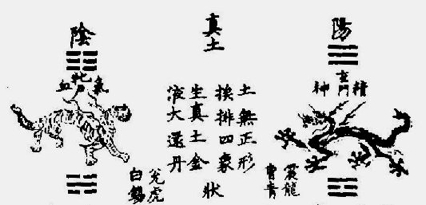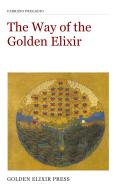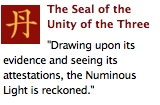An Introduction to Taoist Alchemy
2. Alchemy and Cosmology

On the right, the Dragon (Yang 陽 ☰), on the left, the Tiger (Yin 陰 ☷).
Between them, the characters for True Soil (zhentu 真土), the Center.
Chen Zhixu, Jindan dayao (Great Essentials of the Golden Elixir), ca. 1330.
The doctrinal aspects of alchemy are the main focus of many texts dating from the Tang period (7th-10th centuries) onwards. Unlike the Taiqing scriptures, these texts formulate their teachings and describe their practices using the language and the abstract emblems of ☞ correlative cosmology, a comprehensive system designed to explicate the nature and properties of the cosmos and the human being, and their relations.
This major change was inspired by the ☞ Cantong qi (The Seal of the Unity of the Three), the main text in the history of Chinese alchemy as a whole. Despite this, the Cantong qi does not primarily deal with either Waidan or Neidan. Its main purpose is to describe a way of realization that combines elements from Taoism, cosmology, and alchemy (the "three" mentioned in its title). The task of providing details on this view, and of applying it to either Waidan or Neidan, is left to the commentaries and to a large number of related texts.
The Role of Cosmology
Index of this article
1. The Elixir in External Alchemy
2. The Role of Cosmology
3. Doctrines and Practices of Internal Alchemy
Related materials
The emblems of correlative cosmology are typically arranged in patterns that include ☞ Yin and Yang; the five agents (wuxing); and the ☞ eight trigrams and the sixty-four hexagrams of the Book of Changes (Yijing). In alchemy, these emblems play two main roles, closely related to one another:
(1) First, they illustrate the relation between unity, duality, and the other stages through which the ☞ Original Breath (yuanqi) of the Dao creates the cosmos and propagates into it. From this point of view, the emblems of cosmology show how space, time, multiplicity, and change are related to the spacelessness, timelessness, non-duality, and constancy of the Dao. For instance, the Cantong qi describes the five agents as unfolding from the center, which contains all the main spatial and temporal coordinates of the cosmos, runs through them, and "endows them with its efficacy."
(2) In their second role, the cosmological emblems serve to correlate the doctrinal principles and the alchemical practice. For instance, the trigrams of the Book of Changes are used to illustrate how the alchemical process consists in extracting the pre-cosmic True Yin (zhenyin) and True Yang (zhenyang) from Yang and Yin as they appear in the cosmos. True Yin is represented by the broken line ( ) within Li ☲, and True Yang is represented by the solid line (
) within Li ☲, and True Yang is represented by the solid line ( ) within Kan ☵. When the inner lines of these trigrams are exchanged with one another, they reconstitute Qian ☰ and Kun ☷, the trigrams that represent Original Yang and Original Yin, respectively. Then the conjunction of Qian and Kun produces the Golden Elixir, which is equivalent to the original state of Oneness.
) within Kan ☵. When the inner lines of these trigrams are exchanged with one another, they reconstitute Qian ☰ and Kun ☷, the trigrams that represent Original Yang and Original Yin, respectively. Then the conjunction of Qian and Kun produces the Golden Elixir, which is equivalent to the original state of Oneness.
The Emblematic Functions of Lead and Mercury
The Way of the Golden Elixir
An introduction to Taoist Alchemy, from Waidan to Neidan. PDF, free download.
In this way, alchemy developed a figurative language to represent doctrinal principles, and at the same time a set of practices that are based on those principles and use that language. Waidan lost its ritual features, and the compounding of the Elixir was based on two emblematic metals, Lead and Mercury. The refined states of these metals represent Yin and Yang in their original, pre-cosmic state (Lead is True Yang ☰, Mercury is True Yin ☷), and their conjunction produces the elixir. The central role played by cosmology in these traditions is reflected in two Waidan works related to the Cantong qi, which respectively state that "compounding the Great Elixir is not a matter of ingredients, but always of the five agents," and even that "you do not use ingredients, you use the five agents."
As we shall see in the next section, the Cantong qi had an even more significant influence with regard to Neidan.
◀ Back: 1. External Alchemy
Next: 3. Internal Alchemy ▶





